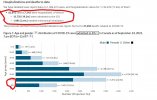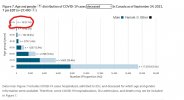cracked_ribs
Well-Known Member
This isn't in response to anything in this thread, more just general information. But I thought it might interest some people - these are just a couple of excerpts from a discussion I was having with a friend of mine who works in a high level research position at a large American institution doing work directly related to this stuff - his field of study is respiratory virology and immunology. He's one of the people I've relied on for information from day one and it was his warning about the radical increase in viral loads from the delta virus (not that this will necessarily worsen symptoms but it probably explains why people with it are so contagious) that made me decide to get vaccinated.
Anyway I'd been chatting with him about the vaccines, and the drop-off in efficacy and whether that was, indeed, an indicator that long term side effects were improbable, and his responses included such a good description of the immune system, how it works, what the pitfalls of vaccine design are, and so on, that I asked if he didn't mind if I posted them publicly. He's such a good source of detailed information I just think it's generally worth a read.
One note: when he says things like "but I'm not an expert in this" he means in the sense that he is not a specialist in that narrow topic, i.e. he doesn't personally look for ways to prod a strand of RNA to replicate proteins to bind to ACE2 receptors or something. His understanding of the topic is light years ahead of normal people's, but at his level everyone is so specialized that he has people doing that specific thing so he has to go take a look at the research to see what the latest on that topic is. By normal people standards, as will probably be obvious from his comments, he's an expert's expert. Yes, casual conversations with him always sound like this.
Anyway this was in response to a question I had about the rapid drop off of vaccine efficacy - this varies from vaccine to vaccine but none of them seem to be the kind of thing where you get a shot as a kid, and you're set for life, that's for sure.
Names concealed to protect the guilty.
Anonymous friend:
Anyway I'd been chatting with him about the vaccines, and the drop-off in efficacy and whether that was, indeed, an indicator that long term side effects were improbable, and his responses included such a good description of the immune system, how it works, what the pitfalls of vaccine design are, and so on, that I asked if he didn't mind if I posted them publicly. He's such a good source of detailed information I just think it's generally worth a read.
One note: when he says things like "but I'm not an expert in this" he means in the sense that he is not a specialist in that narrow topic, i.e. he doesn't personally look for ways to prod a strand of RNA to replicate proteins to bind to ACE2 receptors or something. His understanding of the topic is light years ahead of normal people's, but at his level everyone is so specialized that he has people doing that specific thing so he has to go take a look at the research to see what the latest on that topic is. By normal people standards, as will probably be obvious from his comments, he's an expert's expert. Yes, casual conversations with him always sound like this.
Anyway this was in response to a question I had about the rapid drop off of vaccine efficacy - this varies from vaccine to vaccine but none of them seem to be the kind of thing where you get a shot as a kid, and you're set for life, that's for sure.
Names concealed to protect the guilty.
Anonymous friend:
Antibodies are made by several kinds of cells in the B cell lineage. Once an immune response starts, activated B cells transition from "naive" to different states of activated and then memory cells. Maintaining antibody levels depends on many factors, some of which are unknown, that govern these cellular dynamics. The burst of antibody that we see after immunization comes from plasmablasts and activated B cells. After the immune response peaks, the B cells mostly become memory B cells, though some become long-lived plasma cells. (The plasmablasts are a dead end and die. This cell type is not the same as "long-lived plasma cells.") Memory B cells stop making much antibody, but they are still circulating in the body. The next time they encounter the antigen, the are able to make a lot more antibody very quickly, which provides protection against the virus. Long-lived plasma cells home to the bone marrow, find a comfy spot to hang out, and sit there and pump out antibody on autopilot until the finally die weeks to decades later. Vaccinated people with breakthrough infection make a lot more antibody than unvaccinated people who get infected, so the rapid antibody response in vaccinated people by memory B cells is definitely a big component of the protection. However, the antibody levels against any one virus decrease over time because devoting a disproportionate amount of immunological resources to one virus would likely make us more susceptible to other viruses. There are a lot of exceptions to this generality. Somee pathogens are better at stimulating B cells to become long-lived plasma cells than other pathogens. Measles is a champ, but viruses that are typically limited to infecting the respiratory tract are not good at getting B cells to become long-lived plasma cells.
To add complexity, there are also compartmental differences. The antibodies that everyone is measuring are IgG in the blood stream. The antibodies that are most crucial for protecting against infection are IgA on the surface of the upper respiratory tract. But the antibodies that are most important for preventing serious illness are IgG in the lung, which get there from the blood. The decay kinetics are different for the different antibodies and cell types. IgA decays faster than IgG, which also factors in to why see breakthrough cases (low IgA) and why breakthrough cases are mild (not quite so low IgG and fast response by memory B cells).
Getting back to antigen half-life: if you get too much antigen, you can have a tolerogenic response, i.e. train the immune system NOT to respond. Allergy shots are an example, where you start giving tiny doses of the protein that is causing a problem and then slowly increase the dose. Over time the immune system realizes that it doesn't need to respond to that protein. I think this line of though may be the basis for some of the tin foil hat comments I've read about the vaccine on other forums. Hypothetically, if you got a megadose of the antigen and it stayed around for a long time, the immune system might eventually stop perceiving it as a threat or the antigen itself could cause immune dysfunction. HIV is a good example of chronic antigen screwing with the immune response. Under this ridiculous scenario, the persistent antigen from the vaccine/gene therapy would make us less able to respond to infection and consequently increase morbidity and mortality from infection, thereby bringing to fruition the elites' plan to depopulate the planet. It's crystal clear that breakthrough infections don't cause anywhere near the morbidity of infections occurring in unvaccinated people, so this immunological scenario is obviously fiction. (However, there are some vaccinations where antigen hangs around for a while. The small pox vaccine is a good example. You get a nasty pock on your arm with virus making antigens for weeks. In this case, the virus is sending plenty of different danger signals to the immune system, so there no question that it's a threat.)
Hopefully what I've written makes some sense, and hopefully I've answered your questions. It's late, so I'm not 100% sure of either. I guess to sum it up, the vaccination needs to mimic an acute infection to the degree that there's a bunch of antigen that is cleared relatively rapidly. Given the timing of the cellular response, I don't think there's much benefit to having vaccine antigen hang around for more than ten days to two weeks. My guess is that the antigen from the mRNA vaccines is mostly gone in less than a week, but I haven't done any literature searches to see if the antigen half life in vivo is known. I could be very well be wrong. If anything is unclear, let me know and I'll try to clarify.





